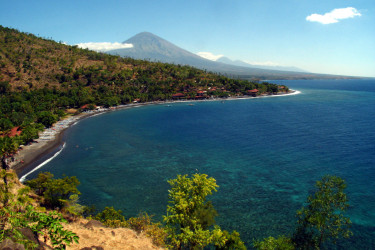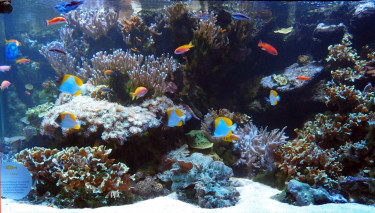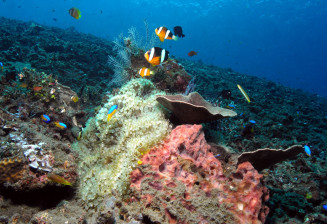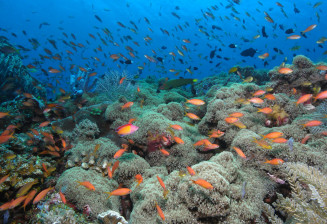Coral reefs

Legende
Récifs coralliens sur la côte de Bali devant le mont Agung.
Credit
© Frederic Fasquel
What is a coral reef?
Coral reefs are constructed through the gradual stacking up of the skeletons of “hard” coral, meaning that they produce a calcareous skeleton. The tropical reefs extend into three main areas located between the Tropic of Capricorn and the Tropic of Cancer: the Indo-Pacific region, stretching from the Indian Ocean to the Pacific Ocean; the Red Sea, Gulf of Aden, Persian Gulf region; the Caribbean region. Each of these three regions is home to its own coral and fish species.

Legende
Bac d'un récif corallien de Nouvelle Calédonie à l'Aquarium tropical
Credit
© Frédéric Fasquel
Which species can be found there?

Amphiprion clarkii sur un récif corallien
© Frederic Fasquel
Coral reefs cover only 0.1% of marine waters yet are home to 25% of marine biodiversity, in other words almost 100,000 species known today! They represent a true oasis of life! They house countless species of colourful fish, shellfish, crustaceans… Algae develop there and serve as food for herbivore fish. A whole food network has been formed, from grazer to predator, enabling the reefs to stay in good ecological health.
The economic benefits of this ecosystem
The coral reefs generate a flourishing tourism business, feed over 30 million people worldwide, protect coasts from erosion by breaking the waves from storms and tsunamis, purify coastal waters, provide many molecules of medical, cosmetic and food value… The economic benefit of the coral reefs worldwide has been estimated at 140 billion euros a year!
An endangered ecosystem

Banc d’Anthias
© Frederic Fasquel
The urbanisation of coastal areas and intensive agriculture have led to land erosion and suffocation of the reefs through an invasion of sediments. Urban pollution has encouraged the development of algae on the reefs. The reefs are sometimes destroyed for construction projects too. Overfishing of edible species has reduced stocks and perturbed the food network. This in turn has led to the proliferation of certain animals such as the Acanthaster planci in Polynesia, an invasive starfish with a voracious appetite for coral polyps.
Climate change is becoming the leading agent of coral destruction, as a result of global warming and the acidification of waters. As a result, it is estimated that by the end of the century, no more than 5 to 10% of current corals will still survive in the oceans. Unless greenhouse gas emissions are immediately and drastically reduced.



